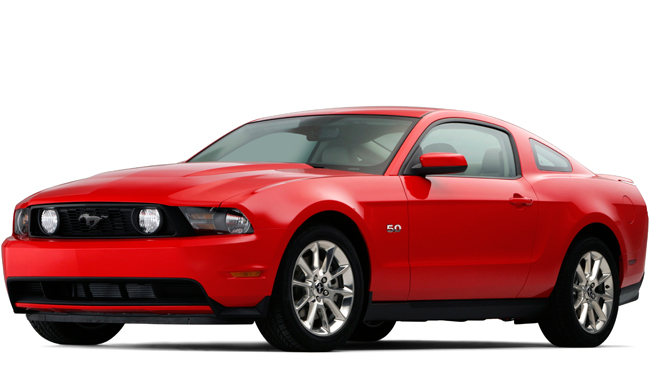UNLESS you’ve been summering in Moscow, you’ll know that Ford Australia’s venerable Boss 5.4-litre V8 has fallen victim to stricter Euro IV emissions regulations that come into force on July 1, and will be replaced by an all-new 5.0-litre V8, dubbed ‘Coyote’ and developed by Ford USA.Wheels has driven the 2011 Ford Mustang, the world’s first Coyote V8-powered Ford, and it’s an absolute cracker. Said our Stateside correspondent: “With its flat torque delivery, steel-cut snarl, and incredibly smooth wind-up to its 7000rpm redline, the 5.0-litre feels more like a European gran turismo thruster than a Detroit donk.“Rated at 307kW and 529Nm in the 1635kg Mustang, the 5.0-litre has no trouble lighting up the rear tyres and making the 100km/h mark in a hair under five seconds.”As reported by Wheels in February, the smaller, lighter, more powerful and economical bent-eight should, in supercharged form at least, catapult FPV ahead of HSV in the performance game. We also cast doubts over the future of XR8, but at the time Ford Oz hosed down speculation. Despite this, rumours of XR8’s imminent demise – to make way for an entry-level, naturally-aspirated FPV – continue to gather momentum.If the rumours prove true, Ford Performance Vehicles will use the Coyote V8 exclusively, and we expect to see it in September, along with minor cosmetic updates to the range.The all-alloy 5.0-litre Coyote V8 tips the scales at 195kg in atmo Mustang spec, 135kg lighter than the Boss 5.4. Even allowing a generous 30kg for a supercharger and intercooler set-up, all Coyote-powered Falcons stand to lose around 100kg. Coupled with the driveability improvements, the performance potential is huge.In Mustang’s naturally-aspirated form, the quad-cam, 32-valve V8 outputs of 307kW and 529Nm would give a 100kg-lighter XR8 a power- to-weight figure of 183kW/tonne (up from 163kW), streets ahead of the Commodore SS’s 152kW/tonne.Add FPV’s Roots-style supercharger installation and outputs climb to an HSV-humbling 335kW/600Nm. In FPV GT guise, we’re talking 191kW/tonne – kicking sand in the face of the HSV Clubsport’s 175kW/tonne.Wheels believes that a big-boost, big-hitting supercharged version of the Coyote will also power the return of the GT-HO in 2011. With higher boost pressure, intake and exhaust mods (see sidebar, opposite page), and a water-to-air intercooler, 375kW/650Nm is well within reach of this reborn legend. If Ford does drop the XR8 and hand the Coyote V8 wholly to FPV it would be a perplexing, but not entirely surprising, move.In January, Ford Australia president and CEO Marin Burela told Wheels, “We’re studying multiple options. One is keeping the XR8 with a different engine calibration for FPV. The second is [dropping XR8] and there’s probably a third option. We don’t have to make a decision until March or April. But we’re prepared either way.”
That ‘decision’ appears to be whether there’s room for both a Ford and FPV V8 in the $50-$55K bracket, or, if not, which badge the atmo V8 will wear.Remember, FPV recently tested the waters with the $54K GS limited-edition model. Anecdotal evidence suggests the GS wasn’t a runaway success, partly because it had little extra power and torque compared with the $6K-cheaper (and lighter) XR8. But a Coyote-powered model should be more successful.But this still doesn’t tell us why Ford would surrender XR8 sales potential, especially to a company in which it owns only a minority 49 percent (Prodrive owns 51 percent). And the XR8 has been a quiet achiever in showrooms – in 2009, 1577 XR8 sedan and utes were sold, which suggests a Coyote-powered XR8 could top 2000 units a year and swing the sales split between XR6T and XR8 (currently 60/40 to the Turbo), in the XR8’s favour.Furthermore, Ford’s decision to drop the XR8 for an FPV cheapie would be unlikely to change anything from a manufacturing perspective, as Ford currently builds the FPV cars before sending them across the road for bumpers, badges, wheels and spoilers.The question then becomes: how many of the XR8’s projected 2000 sales could FPV handle and how many of those sales might be lost? FPV sold 1976 vehicles in the 12 months from February 2009 to Feb 2010. If the switch to the Coyote engine could generate even an additional 1000 sales, the bottom line would be bolstered considerably. And FPV would be breathing down HSV’s neck; Holden’s hot-shop moved 3163 vehicles in the same period.Another consideration is that Ford may be trying to reduce local engine complexity in preparation for Falcon’s new EcoBoost engine and Territory’s new diesel, both due in 2011. With these two engines, plus the existing petrol and LPG in-line sixes, and the turbo I6, the Coyote V8 would bring Ford’s range of local engines to six.Whatever the final outcome, in the Coyote the Blue Oval finally looks to have the V8 firepower to outgun Holden and HSV.





